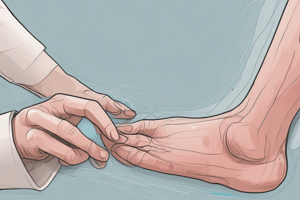Podcast
Questions and Answers
What is the purpose of the E Chart in vision testing?
What is the purpose of the E Chart in vision testing?
- To test near visual acuity in clients who can read
- To test distant visual acuity in clients who can read
- To test vision in clients who cannot read or have a verbal communication handicap (correct)
- To test vision in clients who wear glasses
How far should the client stand from the vision chart during a vision test?
How far should the client stand from the vision chart during a vision test?
- 20 feet (correct)
- 10 feet
- 30 feet
- 40 feet
What does the top number in a vision test result, such as 20/20, represent?
What does the top number in a vision test result, such as 20/20, represent?
- The last full line the client could read
- The client's age
- The distance from the client to the chart (correct)
- The number of letters missed by the client
What should the client do with their glasses during a vision test?
What should the client do with their glasses during a vision test?
What should be recorded if the client misses any letters on a line during a vision test?
What should be recorded if the client misses any letters on a line during a vision test?
What is the purpose of the Snellen Chart in vision testing?
What is the purpose of the Snellen Chart in vision testing?
What type of skin lesions arise from normal skin due to irritation or disease?
What type of skin lesions arise from normal skin due to irritation or disease?
What may be present on some parts of a pressure ulcer?
What may be present on some parts of a pressure ulcer?
What is the term for the base of the ulcer being covered by slough and/or eschar in the wound bed?
What is the term for the base of the ulcer being covered by slough and/or eschar in the wound bed?
What is the purpose of inspecting for lesions during a physical assessment of the skin?
What is the purpose of inspecting for lesions during a physical assessment of the skin?
What type of skin lesion can be either primary or secondary?
What type of skin lesion can be either primary or secondary?
What is a characteristic of vascular skin lesions?
What is a characteristic of vascular skin lesions?
What is indicated when the client moves the chart away from the eyes to focus on the print?
What is indicated when the client moves the chart away from the eyes to focus on the print?
What is the purpose of the near visual acuity procedure?
What is the purpose of the near visual acuity procedure?
What is evaluated during the confrontation test?
What is evaluated during the confrontation test?
What does a delayed or absent perception of the examiner’s finger indicate during the confrontation test?
What does a delayed or absent perception of the examiner’s finger indicate during the confrontation test?
What is assessed during the positions test?
What is assessed during the positions test?
What is the term for an oscillating movement of the eye?
What is the term for an oscillating movement of the eye?
What can be detected when light directed to the blind eye results in no response in either pupil?
What can be detected when light directed to the blind eye results in no response in either pupil?
What is the purpose of testing accommodation of pupils?
What is the purpose of testing accommodation of pupils?
What may be associated with malaligned or low-set ears?
What may be associated with malaligned or low-set ears?
What is indicated by tenderness over the mastoid process?
What is indicated by tenderness over the mastoid process?
What is characterized by foul-smelling, sticky, yellow discharge?
What is characterized by foul-smelling, sticky, yellow discharge?
What can result in conductive hearing loss?
What can result in conductive hearing loss?
What is the primary purpose of Weber's test?
What is the primary purpose of Weber's test?
What is the normal finding in the Rinne test?
What is the normal finding in the Rinne test?
In a client with sensorineural hearing loss, what would be reported during Weber's test?
In a client with sensorineural hearing loss, what would be reported during Weber's test?
What is the purpose of the Romberg test?
What is the purpose of the Romberg test?
What is the normal result in the Romberg test?
What is the normal result in the Romberg test?
What is the abnormal finding in the Rinne test for conductive hearing loss?
What is the abnormal finding in the Rinne test for conductive hearing loss?
Flashcards are hidden until you start studying
Study Notes
Pressure Ulcers
- May have slough or eschar on some parts of the wound
- Can extend into muscle and/or supporting structures
- Unstageable: full-thickness tissue loss with base of the ulcer covered by slough and/or eschar
Physical Assessment: Skin
- Inspect for lesions, noting color, shape, and size
- Primary lesions: arise from normal skin due to irritation or disease
- Secondary lesions: arise from changes in primary lesions
- Vascular lesions: reddish-bluish, seen with bleeding, venous pressure, aging, liver disease, or pregnancy
- Skin cancer lesions: can be primary or secondary, classified as squamous cell carcinoma, basal cell carcinoma, or malignant melanoma
Physical Assessment: Ears
- Inspect the auricle, tragus, and lobule for malaligned or low-set ears (associated with genitourinary disorders or chromosomal defects)
- Palpate the auricle and mastoid process for tenderness or auricular cyst
- Inspect the external auditory canal for redness, swelling, scaling, or itching (otitis externa), or foul-smelling, sticky, yellow discharge
- Inspect the external auditory canal for blood or watery drainage (cerebrospinal fluid) related to skull trauma
Hearing and Equilibrium Tests
- Weber's Test: lateralization of sound to the good ear with sensorineural hearing loss
- Rinne Test: compares air and bone conduction sounds, with normal findings of air conduction sound heard longer than bone conduction sound
- Abnormal findings: conductive hearing loss (bone conduction sound heard longer than or equally as long as air conduction sound) or sensorineural hearing loss (air conduction sound heard longer than bone conduction sound)
- Romberg Test: tests equilibrium, with normal findings of client maintaining position for 20 seconds without swaying or with minimal swaying
Physical Assessment: Eyes
- Test accommodation of pupils, with normal findings of pupils constricting and eyes converging
- External Eye Structure: inspect the eyelids and eyelashes
- Vision Charts: used to test distant visual acuity, with Snellen Chart or E Chart
- Test Results: documented as distance from the client to the chart over the last full line the client could read, with notation of glasses worn during the test
- Near Visual Acuity: test using a hand-held vision chart, with normal findings of N: 14/14 with or without corrective lenses
- Evaluating Vision: test visual fields for gross peripheral vision using the confrontation test
- Extraocular Muscle Function: perform the positions test to assess eye muscle strength and cranial nerve function, with abnormal findings of failure of eyes to follow movement symmetrically in any or all directions
Studying That Suits You
Use AI to generate personalized quizzes and flashcards to suit your learning preferences.





